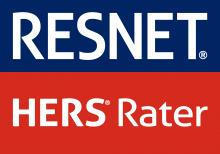It’s officially winter, and that has many of us in Northern Virginia, DC, and Metro Maryland picturing homes covered in snow over the next couple of months. Snow covered roofs and icicles hanging from the gutters may be picturesque at this time of year, but did you know that icicles can actually be a bad sign for your home?
Here’s what you need to know about icicles and ice dams — and what you should do about them if you see them on your roof this winter.
What Are Ice Dams?
If you’ve seen icicles before, you’ve probably seen their sinister close relative, ice dams. Ice dams are heavy ridges of ice that form along the edge of the roof. They are so named ice “dams” because once they form, they prevent any melting snow and ice from draining off of the roof. This can lead to issues like roof leakage and damage to walls, ceilings, and insulation.
Icicles and ice dams form when heat from the attic heats the roof and melts accumulated snow and ice on the roof. This melted snow and ice flows down the roof, only to refreeze at the edge where it is colder.
How to Prevent Ice Dams & Icicles
Icicles and ice dams start with a warm attic and roof, so the key to preventing them is to keep heat from rising into the attic in the first place. Heat naturally rises in the home due to a phenomenon called “stack effect.” When there are air leaks and gaps in insulation throughout a home, stack effect is intensified. Many houses are riddled with air leaks and have low levels of attic insulation, letting up to 25% of indoor heat escape into the attic.
How, then, do you keep heat from rising into the attic? We recommend these simple measures:
Schedule an Energy Audit
If you’re looking to optimize your attic and prevent ice dams in the winter, an energy audit is the perfect place to start. During this in-depth assessment, a home efficiency expert will perform diagnostic testing on your home to pinpoint where it is losing heat and energy. You’ll find out exactly where attic air leaks and insulation gaps are, so you can plan to make targeted home improvements only where you need it.
Seal Air Leaks
After your energy audit, the next step is to seal air leaks — especially those in the attic. Common areas in the attic where air leaks occur are the knee walls, top plates in stud wall cavities, recessed lighting, and attic hatch. Our team removes existing insulation before air sealing and uses high performance spray foam to create an airtight seal along any holes, gaps, and cracks.
Add New Insulation
Once the attic is properly air sealed, it’s time to upgrade the insulation. Our team typically uses blown in cellulose insulation because it offers superior thermal resistance than many other types of insulation, as well as soundproofing and fire resistance. Cellulose is also made from recycled materials, making it an eco friendly insulation choice.
Ensure Proper Ventilation
It’s also important for attics to have proper ventilation along the eaves and peak of the roof. This draws in colder air and vents out any excess attic heat during the winter.






